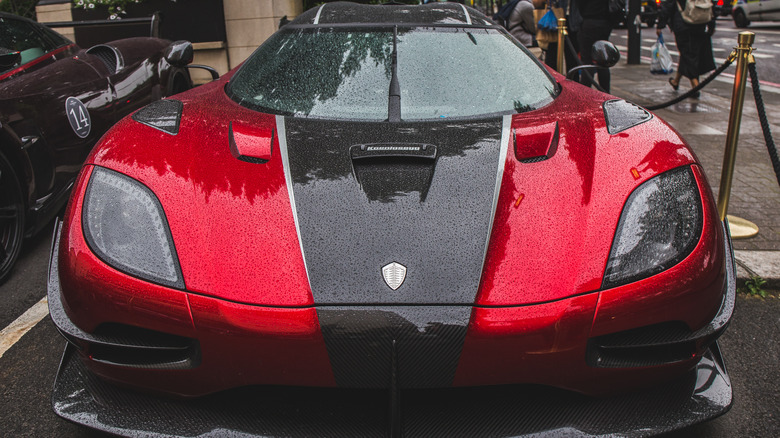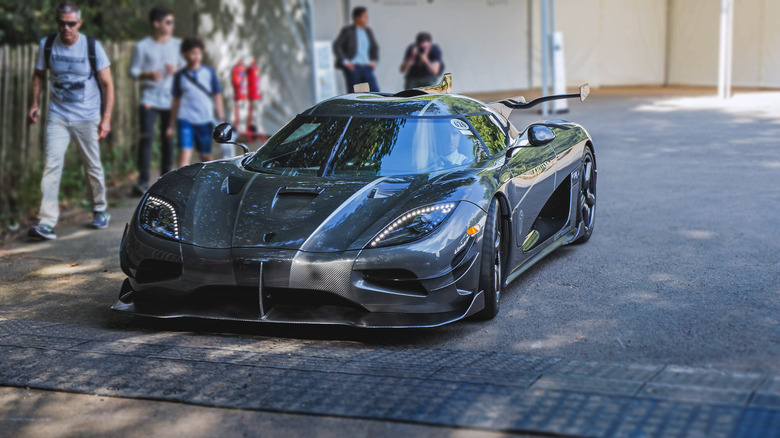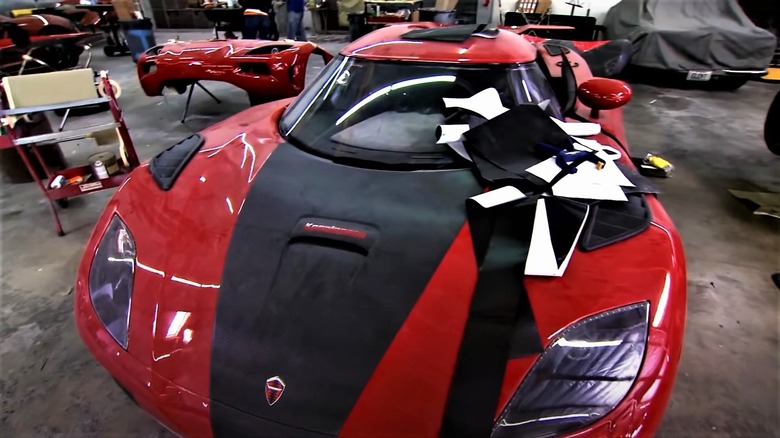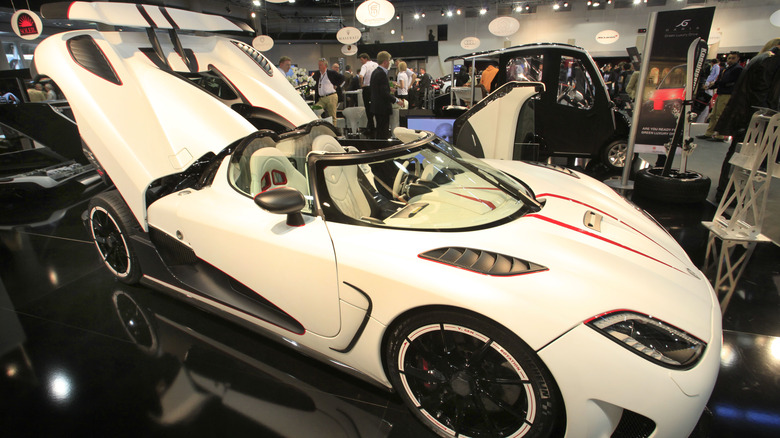The Real Reason Aaron Paul's Car In Need For Speed Is Banned In The US
Aaron Paul got behind the wheel of some fast vehicles in "Need For Speed," but speed isn't the only reason his race-winning hypercar was banned from driving on U.S. soil. In the film, Paul's character Tobey had many crazy chases and death-defying close calls driving a Shelby GT500. However, the car that actually put him on his path to redemption — as well as the one that granted him his sweet victory in the film's culmination — was the Koenigsegg Agera. Now, Koenigseggs are known for taking multiple spots when it comes to the most expensive cars ever produced, and the Agera is no different.
First making its debut at the 2010 Geneva Motor Show, the Agera marked the Swedish supercar manufacturer's 15th anniversary (via Motor Authority). It took Koenigsegg's groundbreaking CC model and turned it into an even better hypercar that produced a monstrous 910 horsepower. In addition, the Agera also showcased a new type of interior lighting system Koenigsegg calls "Ghost Lights." Those who recall the first time the Agera was introduced to Tobey in "Need For Speed" would also remember how his rival Dino — portrayed by actor Dominic Cooper — regarded them.
Dino claims his uncle's three Ageras are basically illegal in the U.S., and that their records technically don't even exist. Well, he wasn't lying, and there's a pretty good reason why people can't see Ageras driving around on American roads bearing legal license plates.
What makes the Agera so illegal in the U.S.?
Owners of an Agera, a car whose name literally meant "to act" in Swedish, will ironically have a hard time acting on its registration. This is due to a number of safety concerns that render these cars unfit for road use, according to Car and Driver. Koenigsegg was reportedly unable to ship the Agera to the U.S. even after years had already passed following its debut. Apparently, the Agera lacked smart airbags required by the National Highway Traffic Safety Administration, and Koenigsegg's exemption on the rule had already expired at the time. The NHTSA is quite strict when it comes to cars that don't meet its safety standards, and the Agera is no exception.
In 2014, a lone Agera had to be recalled after the NHTSA cited that its tire pressure monitoring system didn't meet U.S. standards (via Autoblog). Koenigsegg had shipped only one Agera to the U.S. between 2011 and 2014 and had to locate its sole owner only to update its faulty hardware. Here's the kicker: the Agera's driver never really encountered the issue that the NHTSA flagged, anyway. This just goes to show the NHTSA isn't taking the Agera's road presence lightly, even if it involves just a single unit.
What about the Need For Speed car?
"Need For Speed" placed a lot of supercars of questionable legality on U.S. roads — in open public streets, no less. The cars featured include a ridiculously fast Spania GTA Spano, Lamborghini Sesto Elemento, Bugatti Veyron SS, and of course the Koenigsegg Agera. In an interview with IGN, "Need For Speed" director Scott Waugh said the film opted for real car stunts instead of CGI. In that case, does this mean it actually brought a handful of Ageras to the U.S. to race? Well, not exactly.
Although only three Ageras were depicted in "Need For Speed," the movie utilized a lot more than that during its production. Not all of them were genuine Ageras built by Koenigsegg itself — instead, they were replicas made specifically for filming purposes (via Motor Authority). Above you'll see a video featuring some "Need For Speed" behind-the-scene footage gives a glimpse of how a team created over 15 supercar replicas for the film. This includes faux Ageras that were significantly cheaper than the real thing, yet still had enough performance chops for the movie's action sequences.
The banned Agera comes back with a vengeance
While the original Agera might have had a lengthy ban on U.S. soil, that doesn't mean they never made it to public roads legally. It was only a matter of time before Koenigsegg would come up with a version that it deems "fully road-legal" in the form of the Agera RS. Prior to the Agera RS' arrival, most Koenigseggs brought over to the U.S. were allowed "under exceptional conditions," according to AutoEvolution. In 2015, a year after "Need For Speed" premiered, the Swedish hypercar maker broke the mold by making the Agera RS its first U.S. road safety compliant vehicle.
The very first road-legal example was a special edition variant dubbed the Agera XS and was an RS with a distinct paint job in "Karosserie Orange" as well as a massive rear spoiler. Sure, it might not be the original Agera, or the faster Agera R variant shown in the film, but it's the next best thing. In fact, its manufacturer claims the Agera RS utilizes similar technology to its rare One:1 supercar and has all of the functions of the R and S models, all while maintaining every necessary safety precaution to keep it on U.S. roads. Now that sounds like a story akin to the conclusion in "Need For Speed," wherein Tobey redeemed himself after exacting revenge on his arch-nemesis. Score one for the Agera, which circumvents rules as much as it can crush Bugattis on the streets.



